war crimes

 Andersonville POW camp was a Civil War era POW camp that was heavily fortified. It was run by Captain Henry Wirz, who was tried by a military tribunal on charges of war crimes when the war was over. The trial was presided over by Union General Lew Wallace and featured chief Judge Advocate General (JAG) prosecutor Norton Parker Chipman. The prison is located near Andersonville, Georgia, and today is a national historic site that is also known as Camp Sumpter. To me, its design had a somewhat unusual layout in that it had what is called a “Dead Line”. Some people might know what that is, but any prisoner who dared to tough it, much less try to cross it, found out very quickly what it was, because they were shot instantly…no questions asked. For that reason, prisoners rarely escaped from Andersonville Prison. The “dead line” was set up by the Confederate forces guarding the prison, to assist in prisoner control. The prison operated between February 25, 1864, and May 9, 1864. During that time, a total of 4,588 patients visited the Andersonville prison hospital, and 1,026 never left there alive.
Andersonville POW camp was a Civil War era POW camp that was heavily fortified. It was run by Captain Henry Wirz, who was tried by a military tribunal on charges of war crimes when the war was over. The trial was presided over by Union General Lew Wallace and featured chief Judge Advocate General (JAG) prosecutor Norton Parker Chipman. The prison is located near Andersonville, Georgia, and today is a national historic site that is also known as Camp Sumpter. To me, its design had a somewhat unusual layout in that it had what is called a “Dead Line”. Some people might know what that is, but any prisoner who dared to tough it, much less try to cross it, found out very quickly what it was, because they were shot instantly…no questions asked. For that reason, prisoners rarely escaped from Andersonville Prison. The “dead line” was set up by the Confederate forces guarding the prison, to assist in prisoner control. The prison operated between February 25, 1864, and May 9, 1864. During that time, a total of 4,588 patients visited the Andersonville prison hospital, and 1,026 never left there alive.
According to former prisoner, enlisted soldier John Levi Maile, “It consisted of a narrow strip of board nailed to a row of stakes, about four feet high.” The “dead line” completely encircled Andersonville. Soldiers were told to “shoot any prisoner who touches the ‘dead line'” “It was the standing order to the guards,” Maile explained. “A sick prisoner inadvertently placing his hand on the “dead line” for support… or anyone touching it with suicidal intent, would be instantly shot at, the scattering balls usually striking other than the one aimed at.” It was a risk the prisoners took if they chose to be anywhere near the “dead line” at all. Prisoner Prescott Tracy worked as a clerk in the Andersonville hospital. He said, “I have seen one hundred and fifty bodies waiting passage to the “dead house,” to be buried with those who died in hospital. The average of deaths through the earlier months was thirty a day; at the time I left, the average was over one hundred and thirty, and one day the record showed one hundred and forty-six.” The major threats in the prison camp were diarrhea, dysentery, and scurvy.
A sergeant major in the 16th Regiment Connecticut Volunteers, Robert H. Kellogg what he saw when he entered the camp as a prisoner on May 2, 1864, “As we entered the place, a spectacle met our eyes that almost froze our blood with horror, and made our hearts fail within us. Before us were forms that had once been active and erect…stalwart men, now nothing but mere walking skeletons, covered with filth and vermin. Many of our men, in the heat and intensity of their feeling, exclaimed with earnestness. “Can this be hell?” “God protect us!” and all thought that he alone could bring them out alive from so terrible a place. In the center of the whole was a swamp, occupying about three or four acres of the narrowed limits, and a part of this marshy place had been used by the prisoners as a sink, and excrement covered the ground, the scent arising from which was suffocating. The ground allotted to our ninety was near the edge of this plague-spot, and how we were to live through the warm summer weather in the midst of such fearful surroundings, was more than we cared to think of just then.”
After hearing the accounts of men who had the misfortune of being incarcerated in this horrific POW camp, I 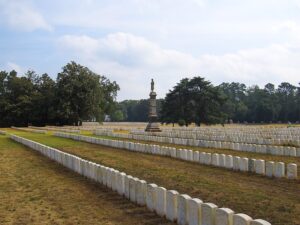
 wondered if there might have been some changes had the camp been run in more modern times. Of course, there is no guarantee of that, since there has been mistreatment of prisoners-of-war in all wars, and the treatment ultimately falls on the people running the camp and the soldiers monitoring the prisoners. It is, however, a sad state of affairs when prisoners are starved, beaten, frozen, and otherwise mistreated in these camps. The point is to hold them, not murder them.
wondered if there might have been some changes had the camp been run in more modern times. Of course, there is no guarantee of that, since there has been mistreatment of prisoners-of-war in all wars, and the treatment ultimately falls on the people running the camp and the soldiers monitoring the prisoners. It is, however, a sad state of affairs when prisoners are starved, beaten, frozen, and otherwise mistreated in these camps. The point is to hold them, not murder them.
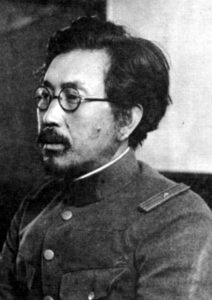 When we think of wartime atrocities, most of us think of the Holocaust, and that was indeed a horrible atrocity. Nevertheless, there have been a number of horrible dictators in history, and most of them committed some kind of atrocity. One of the worst atrocities in history, is one that very few people even know about. Most people have heard about the horrible experiments the Nazis performed on humans. The Nazi doctor, Joseph Mengele headed up that torture practice. But the Nazis weren’t alone in conducting cruel experiments on humans. The Imperial Japanese Army’s Unit 731. Some of the details of this unit’s activities are still uncovered. I don’t understand how anyone could have such little regard for human life, as to conduct some of the horrible experiments n them that some of these dictators and their cohorts did.
When we think of wartime atrocities, most of us think of the Holocaust, and that was indeed a horrible atrocity. Nevertheless, there have been a number of horrible dictators in history, and most of them committed some kind of atrocity. One of the worst atrocities in history, is one that very few people even know about. Most people have heard about the horrible experiments the Nazis performed on humans. The Nazi doctor, Joseph Mengele headed up that torture practice. But the Nazis weren’t alone in conducting cruel experiments on humans. The Imperial Japanese Army’s Unit 731. Some of the details of this unit’s activities are still uncovered. I don’t understand how anyone could have such little regard for human life, as to conduct some of the horrible experiments n them that some of these dictators and their cohorts did.
For 40 years, the horrific activities of “Unit 731” remained one the most closely guarded secrets of World War II. It was not until 1984 that Japan acknowledged what it had done and long denied. The vile experiments on humans conducted by the unit in preparation for germ warfare were atrocious. The Japanese doctors deliberately infected people with plague, anthrax, cholera and other pathogens. It is estimated that as many as 3,000 enemy soldiers and civilians were used as guinea pigs. Some of the more horrific experiments included surgery without anesthesia to see how the human body handled pain, and pressure chambers to see how much pressure a human could take before his eyes popped out.
The compound for Unit 731 was set up in 1938 in Japanese-occupied China with the aim of developing biological weapons. It also operated a secret research and experimental school in Shinjuku, central Tokyo. Its 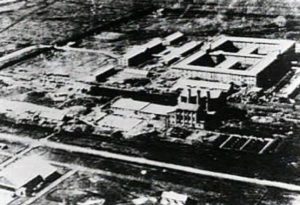 head was Lieutenant Shiro Ishii. Japanese universities and medical schools also supported the unit, by supplying doctors and research staff. I can’t imagine being assigned to such a facility. The picture now emerging about Unit 731’s activities is horrifying. According to reports, which were never officially admitted by the Japanese authorities, the unit used thousands of Chinese and other Asian civilians and wartime prisoners as human guinea pigs to breed and develop killer diseases. Many of the prisoners, who were murdered in the name of research, were used in hideous vivisection and other medical experiments, including barbaric trials to determine the effect of frostbite on the human body. To ease the conscience of those involved, if that is even possible, the prisoners were referred to not as people or patients, but as “Maruta”, which means wooden logs. I suppose they thought it would help, but I doubt if it did.
head was Lieutenant Shiro Ishii. Japanese universities and medical schools also supported the unit, by supplying doctors and research staff. I can’t imagine being assigned to such a facility. The picture now emerging about Unit 731’s activities is horrifying. According to reports, which were never officially admitted by the Japanese authorities, the unit used thousands of Chinese and other Asian civilians and wartime prisoners as human guinea pigs to breed and develop killer diseases. Many of the prisoners, who were murdered in the name of research, were used in hideous vivisection and other medical experiments, including barbaric trials to determine the effect of frostbite on the human body. To ease the conscience of those involved, if that is even possible, the prisoners were referred to not as people or patients, but as “Maruta”, which means wooden logs. I suppose they thought it would help, but I doubt if it did.
Before Japan’s surrender, the site of the experiments was completely destroyed, so that no evidence is left. I don’t suppose we would have known anything had it not been for the pictures that have surfaced, and people who have told the story later. After the site was destroyed, the remaining 400 prisoners were shot and the employees of the unit had to swear secrecy, or risk their own death. The mice kept in the laboratory were then 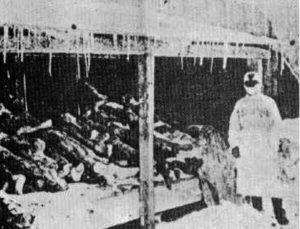 released, which most likely cost the lives of as many as 30,000 people, because the mice were infected with the Bubonic Plague, and they spread the disease. Few of those involved with Unit 731 have admitted their guilt. Some were caught in China at the end of the war, were arrested and detained, but only a handful of them were prosecuted for war crimes. In Japan, not one was brought to justice. In a secret deal, the post-war American administration gave them immunity for prosecution in return for details of their experiments. Some of the worst criminals, including Hisato Yoshimura, who was in charge of the frostbite experiments, went on to occupy key medical and other posts in public and private sectors…their guilty feelings, if they had any, existed only in their own minds.
released, which most likely cost the lives of as many as 30,000 people, because the mice were infected with the Bubonic Plague, and they spread the disease. Few of those involved with Unit 731 have admitted their guilt. Some were caught in China at the end of the war, were arrested and detained, but only a handful of them were prosecuted for war crimes. In Japan, not one was brought to justice. In a secret deal, the post-war American administration gave them immunity for prosecution in return for details of their experiments. Some of the worst criminals, including Hisato Yoshimura, who was in charge of the frostbite experiments, went on to occupy key medical and other posts in public and private sectors…their guilty feelings, if they had any, existed only in their own minds.

 We all know that war is a nasty, messy, vicious event. Nevertheless, sometimes war is necessary. Unfortunately, in our world, evil exists, and sometimes the evil is in the form of a dictator, a nation, or a religious group. Wars might be fought differently, but the end result is the same…death and destruction. Still, most wars have an ending point. One side surrenders, and admits defeat. That might seem like the end of the story, but it isn’t. All too often the process of cleaning up the mess after the war, takes far longer than the war itself. In fact, sometimes the cleanup never really happens at all. Such was the case with landmines in Angola. These mines are a legacy of over four decades of fighting during a 14 year war of independence against its former colonial ruler of Portugal and another 30 years of civil war. Like people who put signs up to advertise a garage sale, sometimes they don’t remember where all the landmines were, or maybe they did, and simply didn’t care. Either way, the landmines were killing and maiming people…innocent people. That was the mission my 16th cousin once removed, Princess Diana took upon herself. She wanted an international ban on landmines. Her comments, which were made during a January 15, 1997 visit to Angola to see for herself some of the victims of landmines, were seen as out of step with government policy by the Junior Defense Minister, Earl Howe, who described the princess as a “loose cannon”, ill-informed on the issue of anti-personnel landmines. Nevertheless, Diana was right about the weapons of war that were left behind. The task of cleaning up the mess may have been a daunting one, but the result of leaving them behind was gruesome.
We all know that war is a nasty, messy, vicious event. Nevertheless, sometimes war is necessary. Unfortunately, in our world, evil exists, and sometimes the evil is in the form of a dictator, a nation, or a religious group. Wars might be fought differently, but the end result is the same…death and destruction. Still, most wars have an ending point. One side surrenders, and admits defeat. That might seem like the end of the story, but it isn’t. All too often the process of cleaning up the mess after the war, takes far longer than the war itself. In fact, sometimes the cleanup never really happens at all. Such was the case with landmines in Angola. These mines are a legacy of over four decades of fighting during a 14 year war of independence against its former colonial ruler of Portugal and another 30 years of civil war. Like people who put signs up to advertise a garage sale, sometimes they don’t remember where all the landmines were, or maybe they did, and simply didn’t care. Either way, the landmines were killing and maiming people…innocent people. That was the mission my 16th cousin once removed, Princess Diana took upon herself. She wanted an international ban on landmines. Her comments, which were made during a January 15, 1997 visit to Angola to see for herself some of the victims of landmines, were seen as out of step with government policy by the Junior Defense Minister, Earl Howe, who described the princess as a “loose cannon”, ill-informed on the issue of anti-personnel landmines. Nevertheless, Diana was right about the weapons of war that were left behind. The task of cleaning up the mess may have been a daunting one, but the result of leaving them behind was gruesome.
Of course, these weren’t the only messes that needed to be cleaned up after a war. There were buildings to be rebuilt, the dead to bury, the economy to build up, and the government often had to be restructured. The country might have been the enemy, but if things weren’t handled right after the surrender, the same evil people might move right back into power. Of course, cleaning up the mess…often known as policing the nation that has now surrendered, is no easy task either. Most people don’t want the winning army there. Their country is nothing like it used to be. Some believe that is a good thing, but it was still their home, and now everything feels…wrong. Their homes are destroyed, food is can be scarce…water too. Everything they have known for their whole life is gone. No wonder they don’t want the army there…or maybe they secretly do, because their home has become just a very scary place. I suppose that is why a part of the surrender agreements include restoration of the country, and the new government and police.
One more part of cleaning up the mess is the task of trying the perpetrators for their war crimes. That was the main reason that Hitler took his own life. He knew that he would be tried and convicted of the crimes he had committed, and he couldn’t face what would follow. He would have been left to the mercy of his countrymen, 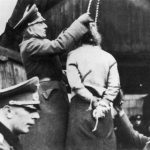
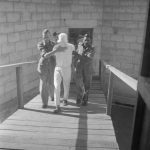 and he would have ended up being hung, like Saddam Hussein was for his war crimes. A dictator can’t brutally kill the people who he is in power over and not be hated…truly hated, no matter what the people act like when they are forced to act loyal. The trials for war crimes in many ways seems to the world, as if one nation is trying to be the world police. The United States has been accused of this before, but the reality remains, that someone has to try these evil criminals, and someone has to clean up the mess. In the absence of another nation to step up, the job usually falls to the United States.
and he would have ended up being hung, like Saddam Hussein was for his war crimes. A dictator can’t brutally kill the people who he is in power over and not be hated…truly hated, no matter what the people act like when they are forced to act loyal. The trials for war crimes in many ways seems to the world, as if one nation is trying to be the world police. The United States has been accused of this before, but the reality remains, that someone has to try these evil criminals, and someone has to clean up the mess. In the absence of another nation to step up, the job usually falls to the United States.

 I have always been somewhat amazed that, after a war is over, it seems that there must follow a trial for war crimes. It isn’t so much the trial, the obvious crimes against humanity that are always a part of war, or even the outrage over it all, that most amazes me, but rather the fact that even in war, people are expected to follow certain standards, or rules of engagement. I think that there are evil people on either side of a war, but some wars seem to have more evil involved than others…or maybe we were just more appalled in earlier wars. I think that is a possibility, because we have all become less shocked by the heinous acts people are able to perform. Still, I am completely shocked that they can stomach such things without becoming violently ill.
I have always been somewhat amazed that, after a war is over, it seems that there must follow a trial for war crimes. It isn’t so much the trial, the obvious crimes against humanity that are always a part of war, or even the outrage over it all, that most amazes me, but rather the fact that even in war, people are expected to follow certain standards, or rules of engagement. I think that there are evil people on either side of a war, but some wars seem to have more evil involved than others…or maybe we were just more appalled in earlier wars. I think that is a possibility, because we have all become less shocked by the heinous acts people are able to perform. Still, I am completely shocked that they can stomach such things without becoming violently ill.
The horrible crimes committed against the Jews and the Gypsies prior to and during World War II, were crimes 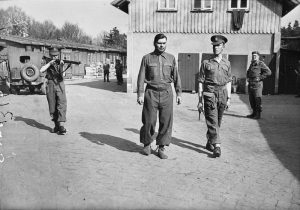 that the Allies simply could not overlook. The Belsen trial was one of several trials the Allied occupation forces held against former officials of Nazi Germany after the end of the war. The Belsen trial took place in Lüneburg, Lower Saxony, Germany in 1945. The defendants were men and women of the SS as well as prisoner officials who had worked at various concentration camps, notably Auschwitz and Bergen-Belsen. People around the world were interested in these trials, and as the public heard for the first time from some of those responsible for the mass murder in the eastern extermination camps, they were filled with contempt. Some later trials are also referred to as Belsen trials, a name that became synonymous with war crime trails of World War II.
that the Allies simply could not overlook. The Belsen trial was one of several trials the Allied occupation forces held against former officials of Nazi Germany after the end of the war. The Belsen trial took place in Lüneburg, Lower Saxony, Germany in 1945. The defendants were men and women of the SS as well as prisoner officials who had worked at various concentration camps, notably Auschwitz and Bergen-Belsen. People around the world were interested in these trials, and as the public heard for the first time from some of those responsible for the mass murder in the eastern extermination camps, they were filled with contempt. Some later trials are also referred to as Belsen trials, a name that became synonymous with war crime trails of World War II.
When the trials ended, and those who chose to commit such horrible acts as the Holocaust, Porajmos, and other war related crimes were found guilty, it was time for the next step in the justice process…carrying out the 
 sentencing. A report was made on November 18, 1945, regarding the completion of the Belsen Trial the day before, and the final outcome of said trial. Then, on December 13, 1945, Joseph Kramer and Irma Grese, the monarchs of Belsen were two of the people hanged for Nazi concentration camp crimes, according to the sentences imposed on them after the trial. Nine other concentration staff members were also hanged on the same day. Sentencing and the carrying out of said sentence was certainly handled more quickly than they would have been in this day and age.
sentencing. A report was made on November 18, 1945, regarding the completion of the Belsen Trial the day before, and the final outcome of said trial. Then, on December 13, 1945, Joseph Kramer and Irma Grese, the monarchs of Belsen were two of the people hanged for Nazi concentration camp crimes, according to the sentences imposed on them after the trial. Nine other concentration staff members were also hanged on the same day. Sentencing and the carrying out of said sentence was certainly handled more quickly than they would have been in this day and age.
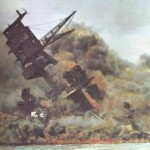
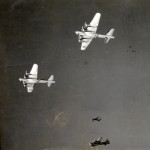 World War II had been raging since September 1, 1939. It was without doubt the most destructive war in history. Some say it was simply a continuation of World War I, that had ended in 1918. Others will blame the 1931 Japanese seizure of Manchuria from China, or Italy’s invasion and defeat of Ethiopia in 1935, or Adolf Hitler’s re-militarization of Germany in 1936, or the Spanish Civil War 1936 to 1939, or Germany’s occupation of Czechoslovakia in 1938 as possible beginnings. But, the two dates most often mentioned as “the beginning of World War II” are July 7, 1937, when the “Marco Polo Bridge Incident” led to war between Japan and China, and September 1, 1939, when Germany invaded Poland, which led Britain and France to declare war on Hitler’s Nazi state in retaliation. To me it would seem that the tensions that had begun before World War I, simply never went away. It would seem that there were many world leaders who were power hungry, and greedy for the lands that belonged to their neighbors. And when you look at the Middle East today, maybe not much has really changed.
World War II had been raging since September 1, 1939. It was without doubt the most destructive war in history. Some say it was simply a continuation of World War I, that had ended in 1918. Others will blame the 1931 Japanese seizure of Manchuria from China, or Italy’s invasion and defeat of Ethiopia in 1935, or Adolf Hitler’s re-militarization of Germany in 1936, or the Spanish Civil War 1936 to 1939, or Germany’s occupation of Czechoslovakia in 1938 as possible beginnings. But, the two dates most often mentioned as “the beginning of World War II” are July 7, 1937, when the “Marco Polo Bridge Incident” led to war between Japan and China, and September 1, 1939, when Germany invaded Poland, which led Britain and France to declare war on Hitler’s Nazi state in retaliation. To me it would seem that the tensions that had begun before World War I, simply never went away. It would seem that there were many world leaders who were power hungry, and greedy for the lands that belonged to their neighbors. And when you look at the Middle East today, maybe not much has really changed.
Wherever you place the beginning of World War II, you would agree that while the Japanese and the Germans may not have been war weary, the rest of the world really was. Before the Japanese attacked Pearl Harbor on December 7, 1941, the United States had somehow managed to stay out of the conflict. Whether that was right or wrong is a matter of opinion too. Nevertheless, when the Japanese brought the war to our front door, the United States answered with a vengeance. I’m sure the allies were glad to have the reinforcements, but also wondered why it had taken so long for us to get involved. Sometimes, I have wondered that myself, about that and other wars that we have come into just a little bit late in the game.
That said, we got into the war, and I believe that the extra military might that the United States brought to the Allied Forces was the tipping point in the war, because a war that had officially raged since September 1, 1939, was brought to an end on September 2, 1945, when Victory over Japan was celebrated in the United States. Japanese troops finally surrendered to Americans on the Caroline, Mariana, and Palau islands. Representatives of their emperor and prime minister were preparing to formalize their declaration of defeat. In Tokyo Bay, aboard the Navy battleship USS Missouri, Japanese foreign minister, Mamoru Shigemitsu and chief of staff of the Japanese army, Yoshijiro Umezu, signed the “instrument of surrender.” General Douglas MacArthur, commander of the US Army forces in the Pacific, and Admiral Chester Nimitz, commander of the US Pacific Fleet were there to represent the Allied victors.
After the surrender, Mamoru Shigemitsu was found guilty of war crimes. He was sentenced to seven years in prison. Oddly, it was he who had fought for concessions on the Japanese side in an attempt to secure an early peace. He was paroled in 1950 and went on to become chairman of Japan’s Progressive Party. General 
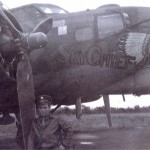 MacArthur would come up against him again when he was named commander in chief of the United Nations forces in Korea in 1950. For some people, it would seem, that one defeat simply isn’t enough, but that is another story. Today is VJ Day…Victory over Japan Day. It may not be a day that we remember as well as we do D Day, which simply stands for the day designated to storm the beaches at Normandy, or the attack on Pearl Harbor, but VJ Day is in reality as important a day as those others too, because it was the day that ended the world’s worst, and most destructive war.
MacArthur would come up against him again when he was named commander in chief of the United Nations forces in Korea in 1950. For some people, it would seem, that one defeat simply isn’t enough, but that is another story. Today is VJ Day…Victory over Japan Day. It may not be a day that we remember as well as we do D Day, which simply stands for the day designated to storm the beaches at Normandy, or the attack on Pearl Harbor, but VJ Day is in reality as important a day as those others too, because it was the day that ended the world’s worst, and most destructive war.

